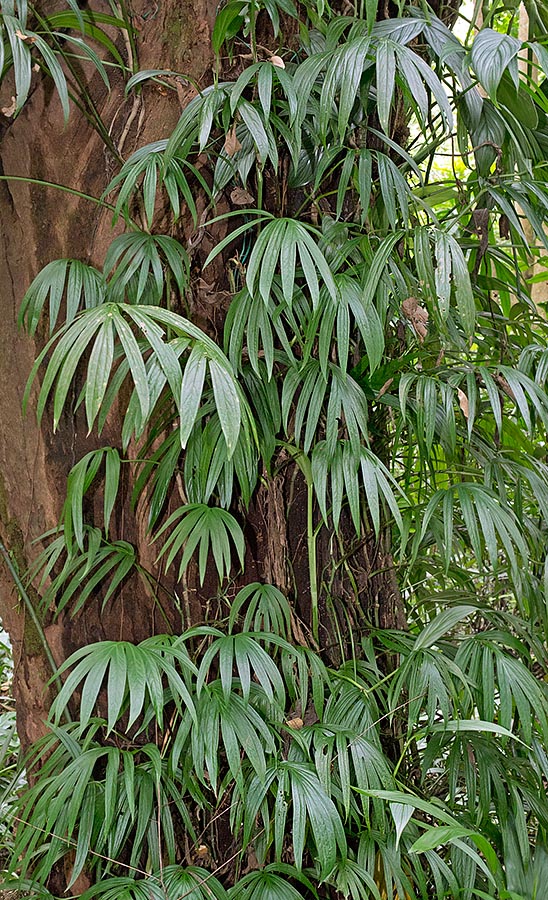Family : Araceae

Text © Pietro Puccio

English translation by Mario Beltramini

Amydrium zippelianum is an elegant Araceae with even 4 m long stems © Giuseppe Mazza
The species is native to Maluku Islands, Papua New Guinea, Philippines and Sulawesi, where it grows in the pluvial forests from the sea level up to about 1800 m of altitude.
The name of the genus comes from the Greek “amydron” = obscure, vague, of unclear reference; the species is honoured to the Dutch botanist and collector Alexander Zippelius (1797-1848).
The Amydrium zippelianum (Schott) Nicolson (1968) is an herbaceous evergreen species, prostrate or climbing, with up to about 4 m long stems with 2-3,5 cm of diameter and robust aerial roots at the nodes, of about 0,4 cm of diameter, with which it adheres to the trunks or to the rocks to which it leans.
The leaves, on a 20-35 cm long petiole grooved on top, are alternate, ovate with cordate base, rather pinnate, 50-90 cm long and 30-50 cm broad, without fenestrations, with lobes drooping from the pointed apices, of bright green colour. The inflorescences, produced at the apices and subtended by numerous blackish cataphylls (modified leaves having no chlorophyll having a protective function) which decompose in a fibrous mass, are erect and formed by a sessile or pedunculate spadix, cylindrical, 6-8 cm long and of 1,5-2 cm of diameter, initially yellow, surrounded by a fleshy spathe ovate-oblong, 14 cm long and 6 cm broad, yellow, which quickly blackens, deciduous.
The flowers are bisexual, without corolla, with 4 stamina and tetragonal gynoecium; the fruits are berries initially greenish white turning orange when ripe, which form a compound cylindrical fruit about 20 cm long and of 5 cm of diameter, containing 1-2 reniform seeds, about 1 cm long, immersed in a gelatinous pulp. It reproduces by seed and easily by 10-20 cm long portions of stem, without the leaves, in organic loam kept humid at a temperature of 22-24 °C.
Very ornamental species, it is cultivable in the tropical and humid subtropical climate zones in very luminous position, but not in direct sun, on draining soils rich of organic substance, acidic or neutral, kept humid, leant on trees or rocks.
Where the climate does not allow the continuous permanence in open air, it may be cultivated in greenhouses, winter gardens and luminous verandas, with lowest temperatures above the 14-16 °C, utilizing pots equipped with a support covered with moss, or synthetic material capable to hold the humidity, on which it can climb, in organic loam with addition of coarse sand or crushed stone for improving the drainage. The waterings must be frequent in summer, reduced in winter, utilizing for the fertilizations hydro soluble products with which to sprinkle leaves and aerial roots.
Synonyms: Pothos miniatus Zipp. ex Schott (1863); Rhaphidophora zippeliana Schott (1863); Epipremnum asperatum Engl. (1879); Epipremnum zippelianum (Schott) Engl. (1881); Epipremnum magnificum Engl. (1879); Rhaphidophora warburgii Engl. (1905); Epipremnum elmerianum Engl. (1908); Epipremnum philippinense Engl. & K.Krause (1908); Epipremnum luzonense K.Krause (1911); Epipremnum mampuanum Alderw. (1920); Epipremnopsis magnifica (Engl.) Alderw. (1922); Epipremnopsis zippeliana (Schott) Alderw. (1922); Epipremnum miniatum Elmer ex Merr. (1922); Epipremnum sorsogonense Elmer ex Merr. (1922); Epipremnum miniatum Elmer (1938); Amydrium magnificum (Engl.) Nicolson (1968).
